Papers by Dennis Fernandes Alves Bessada
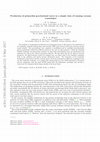
International Journal of Modern Physics D, Mar 9, 2017
The problem of cosmological production of gravitational waves is discussed in the framework of an... more The problem of cosmological production of gravitational waves is discussed in the framework of an expanding, spatially homogeneous and isotropic FRW type Universe with time-evolving vacuum energy density. The gravitational wave equation is established and its modified time-dependent part is analytically resolved for different epochs in the case of a flat geometry. Unlike the standard ΛCDM cosmology (no interacting vacuum), we show that gravitational waves are produced in the radiation era even in the context of general relativity. We also show that for all values of the free parameter, the high frequency modes are damped out even faster than in the standard cosmology both in the radiation and matter-vacuum dominated epoch. The formation of the stochastic background of gravitons and the remnant power spectrum generated at different cosmological eras are also explicitly evaluated. It is argued that measurements of the CMB polarization (B-modes) and its comparison with the rigid ΛCDM model plus the inflationary paradigm may become a crucial test for dynamical dark energy models in the near future.
Physical review, Oct 25, 2013
In this work we study the evolution of matter-density perturbations for an arbitrary Λ(t) model, ... more In this work we study the evolution of matter-density perturbations for an arbitrary Λ(t) model, and specialize our analysis to the particular phenomenological law Λ = Λ0 + 3βH 2. We study the evolution of the cosmic star formation rate in this particular dark energy scenario and, by constraining the β parameter using both the age of the universe and the cosmic star formation rate curve, we show that it leads to a reasonable physical model for β 0.1.
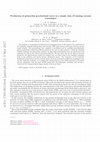
arXiv (Cornell University), Mar 20, 2015
The problem of cosmological production of gravitational waves is discussed in the framework of an... more The problem of cosmological production of gravitational waves is discussed in the framework of an expanding, spatially homogeneous and isotropic FRW type Universe with time-evolving vacuum energy density. The gravitational wave equation is established and its modified time-dependent part is analytically resolved for different epochs in the case of a flat geometry. Unlike the standard ΛCDM cosmology (no interacting vacuum), we show that gravitational waves are produced in the radiation era even in the context of general relativity. We also show that for all values of the free parameter, the high frequency modes are damped out even faster than in the standard cosmology both in the radiation and matter-vacuum dominated epoch. The formation of the stochastic background of gravitons and the remnant power spectrum generated at different cosmological eras are also explicitly evaluated. It is argued that measurements of the CMB polarization (B-modes) and its comparison with the rigid ΛCDM model plus the inflationary paradigm may become a crucial test for dynamical dark energy models in the near future.
Prometeica, Dec 31, 1969
Prometeica: Professor Dennis, em uma conversa recente que tivemos, fui surpreendida pelo seu come... more Prometeica: Professor Dennis, em uma conversa recente que tivemos, fui surpreendida pelo seu comentário de que a "teoria do Big Bang" não seria completamente uma teoria! Tanto os livros didáticos, como a mídia em geral, a apresentam e divulgam como tal. Afinal, a "teoria do Big Bang" é ou não é uma teoria? Seria um modelo? Essa é uma questão conceitual bem interessante, e está intrinsecamente associada ao desenvolvimento de nossas concepções sobre a origem e a evolução do universo. Sem entrar em definições rigorosas, podemos dizer que um modelo cosmológico envolve uma proposta simplificada de explicação para um determinado fenômeno observado no universo, e tal proposta é baseada em um conjunto de equações e princípios físicos. Já uma teoria cosmológica é mais abrangente e complexa do que um modelo, já que, além de outros fatores, deve
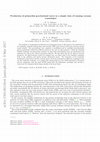
arXiv (Cornell University), Mar 20, 2015
The problem of cosmological production of gravitational waves is discussed in the framework of an... more The problem of cosmological production of gravitational waves is discussed in the framework of an expanding, spatially homogeneous and isotropic FRW type Universe with time-evolving vacuum energy density. The gravitational wave equation is established and its modified time-dependent part is analytically resolved for different epochs in the case of a flat geometry. Unlike the standard ΛCDM cosmology (no interacting vacuum), we show that gravitational waves are produced in the radiation era even in the context of general relativity. We also show that for all values of the free parameter, the high frequency modes are damped out even faster than in the standard cosmology both in the radiation and matter-vacuum dominated epoch. The formation of the stochastic background of gravitons and the remnant power spectrum generated at different cosmological eras are also explicitly evaluated. It is argued that measurements of the CMB polarization (B-modes) and its comparison with the rigid ΛCDM model plus the inflationary paradigm may become a crucial test for dynamical dark energy models in the near future.

arXiv (Cornell University), Mar 20, 2015
The problem of cosmological production of (massless) gravitons is discussed in the framework of a... more The problem of cosmological production of (massless) gravitons is discussed in the framework of an expanding, spatially homogeneous and isotropic FRW type Universe with decaying vacuum energy density ($\Lambda \equiv \Lambda(H(t))$) described by general relativity theory. The gravitational wave equation is established and its modified time-dependent part has analytically been solved for different epochs in the case of a flat geometry. Unlike the standard $\Lambda$CDM cosmology (no interacting vacuum), we show that massless gravitons can be produced during the radiation era. However, for all values of the free parameter, the high frequency modes are damped out even faster than in the standard cosmology both in the radiation and matter-vacuum dominated epoch. The formation of the stochastic background of gravitons and the remnant power spectrum generated at different cosmological eras are also explicitly evaluated.
Revista Música, 2014
Nesse artigo apresento o conceito de Harmonia das Esferas conforme formulado inicialmente pelos p... more Nesse artigo apresento o conceito de Harmonia das Esferas conforme formulado inicialmente pelos pitagóricos. Partindo dos fragmentos de Filolau e das descrições de Aristóteles do pensamento pitagórico, traçarei um panorama geral das concepções pitagóricas acerca do número, do universo, e das consonâncias musicais, para então discutir como essas ideias geraram o conceito de Harmonia das Esferas.
ABSTRACT Number of Pages: 206
Physical Review D, 2013
In this work we study the evolution of matter-density perturbations for an arbitrary Λ(t) model, ... more In this work we study the evolution of matter-density perturbations for an arbitrary Λ(t) model, and specialize our analysis to the particular phenomenological law Λ = Λ0 + 3βH 2. We study the evolution of the cosmic star formation rate in this particular dark energy scenario and, by constraining the β parameter using both the age of the universe and the cosmic star formation rate curve, we show that it leads to a reasonable physical model for β 0.1.
We study here three different theories of gravity with massive gravitons, namely, the modified Fi... more We study here three different theories of gravity with massive gravitons, namely, the modified Fierz-Pauli model, bimetric theory, and "massive gravity". In particular, we show that the vector gravitational-wave polarization modes, in the modified Fierz-Pauli theory, can give rise to an unusual vector Sachs-Wolfe effect leaving a signature in the quadrupole form on the cosmic microwave background (CMB) radiation polarization. As an additional result, we numerically solve the Boltzmann equations for the massive tensor modes obtaining the correlation function C T T l. This result shows that massive gravitons can leave a signature on the spectrum of CMB for low multipoles.
The Twelfth Marcel Grossmann Meeting, 2012
... ODYLIO D. AGUIAR, MÁRCIO ES ALVES, JOAQUIM J. BARROSO, DENNIS F. A BESSADA,CLAUDIO SS BRANDÃ... more ... ODYLIO D. AGUIAR, MÁRCIO ES ALVES, JOAQUIM J. BARROSO, DENNIS F. A BESSADA,CLAUDIO SS BRANDÃO ... NEI F. OLIVEIRA JR, XAVIER PM GRATENS, SÉRGIO T. DE SOUZA Instituto de Física, Universidade de São Paulo, São Paulo, SP, Brazil ...
Physical Review D, 2013
In this work I discuss the dynamical and thermodynamical equivalence between a general kessence s... more In this work I discuss the dynamical and thermodynamical equivalence between a general kessence scalar field cosmology and an arbitrary cosmological model with a decaying vacuum, thus generalizing the approach proposed by Maia and Lima [Phys. Rev. D 65, 083513 (2002)]. The formalism obtained is quite general and holds for any non-canonical scalar field model. As a special case I derive a Dirac-Born-Infeld (DBI) model with an exponential potential and constant speed of sound, and show that it is equivalent to a cosmological model with decay law Λ(H) = 3βH 2 .
Journal of Physics: Conference Series, 2012
Here we present a status report of the Schenberg antenna. In the past three years it has gone to ... more Here we present a status report of the Schenberg antenna. In the past three years it has gone to a radical upgrading operation, in which we have been installing a 1K pot dilution refrigerator, cabling and amplifiers for nine transducer circuits, designing a new suspension and vibration isolation system for the microstrip antennas, and developing a full set of new transducers, microstrip antennas, and oscillators. We are also studying an innovative approach, which could transform Schenberg into a broadband gravitational wave detector.
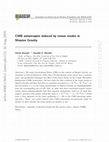
Journal of Cosmology and Astroparticle Physics, 2009
We study Gravitational Waves (GWs) in the context of Massive Gravity, an extension to General Rel... more We study Gravitational Waves (GWs) in the context of Massive Gravity, an extension to General Relativity (GR) where the fluctuations of the metric have a nonzero mass, and specifically investigate the effect of the tensor modes on the Cosmic Microwave Background (CMB) anisotropies. We first study the time evolution of the tensor modes in Massive Gravity and show that there is a graviton mass limit m l = 10 −66 g ∼ 10 −29 cm −1 , so that for masses m ≤ m l the tensor perturbations in Massive Gravity are indistinguishable from the corresponding ones in GR. Also, we show that short wavelength massive modes behave almost indistinguishably from their massless counterparts. Later on, we show that massive gravitons with masses within the range m = 10 −27 cm −1-m = 10 −26 cm −1 would leave a clear signature on the lower multipoles (ℓ < 30) in the CMB anisotropy power spectrum. Hence, our results indicate that CMB anisotropies measurements might be decisive to show whether the tensor modes are massive or not.
Journal of Cosmology and Astroparticle Physics, 2012
I investigate non-Gaussian signatures in the context of tachyacoustic cosmology, that is, a nonin... more I investigate non-Gaussian signatures in the context of tachyacoustic cosmology, that is, a noninflationary model with superluminal speed of sound. I calculate the full non-Gaussian amplitude A, its size fNL, and corresponding shapes for a red-tilted spectrum of primordial scalar perturbations. Specifically, for cuscuton-like models I show that fNL ∼ O(1), and the shape of its non-Gaussian amplitude peaks for both equilateral and local configurations, the latter being dominant. These results, albeit similar, are quantitatively distinct from the corresponding ones obtained by Magueijo et. al in the context of superluminal bimetric models.
Journal of Cosmology and Astroparticle Physics, 2012
The spectrum and amplitude of the stochastic background of relic gravitons produced in a bouncing... more The spectrum and amplitude of the stochastic background of relic gravitons produced in a bouncing universe is calculated. The matter content of the model consists of dust and radiation fluids, and the bounce occurs due to quantum cosmological effects when the universe approaches the classical singularity in the contracting phase. The resulting amplitude is very small and it cannot be observed by any present and near future gravitational wave detector. Hence, as in the ekpyrotic model, any observation of these relic gravitons will rule out this type of quantum cosmological bouncing model.
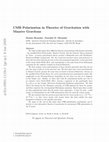
Classical and Quantum Gravity, 2009
We study in this paper three different theories of gravitation with massive gravitons-the modifie... more We study in this paper three different theories of gravitation with massive gravitons-the modified Fierz-Pauli model, Massive Gravity and the bimetric theory proposed by Visser-in linear perturbation theory around a Minkowski and a flat Friedmann-Robertson-Walker background. For the transverse-traceless tensor perturbations we show that the three theories give rise to the same dynamical equations, to the same form of the tensor Sachs-Wolfe effect, and consequently to the same form of the Boltzmann equations for the radiative transfer in General Relativity. We then analyze vector perturbations in these theories and show that they do not give the same results as in the previous case. We first show that vector perturbations in Massive Gravity present the same form as found in General Relativity, whereas in the modified Fierz-Pauli theory the vector gravitational-wave polarization modes (Ψ 3 amplitudes in the Newman-Penrose formalism) do not decay too fast as it happens in the former case. Rather, we show that such Ψ 3 polarization modes give rise to an unusual vector Sachs-Wolfe effect, leaving a signature in the quadrupole form Y 2,±1 (θ, ϕ) on the Cosmic Microwave Background Radiation polarization. We then derive the details for the Thomson scattering of CMB photons for these Ψ 3 modes, and then construct the correspondent Boltzmann equations. Based upon these results we then qualitatively show that Ψ 3-mode vector signatures-if they do exist-could clearly be distinguished on the CMB polarization from the usual Ψ 4 tensor modes. We also estimate that the graviton mass limit for the vector modes is m = 10 −66 g ∼ 10 −29 cm −1 , so that vector modes with masses below this limit exhibit the same dynamical evolution as the massless gravitons. We argue at the end of this paper that CMB polarization experiments can be decisive to test alternative theories of gravitation by measuring CMB polarization in the E-mode.










Uploads
Papers by Dennis Fernandes Alves Bessada